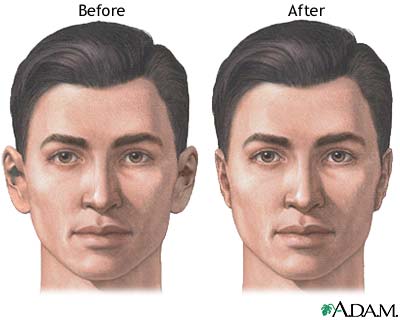
|
Ear Surgery |
|
Ear surgery or otoplasty is usually done to set prominent ears back closer to the head or to reduce the size of large ears. Ears are almost fully grown by age four, so the operation is done on children between ages of four and fourteen. Ear surgery is also possible in adults with fewer risks. You have to be clear about what and how you want your ear to be when you talk to the doctor. Risks involved: •When a qualified and experienced surgeon performs the ear surgery, the complications and risks involved are usually minor. •Patients may develop a blood clot on the ear. It can dissolve naturally or drawn out with a needle. •Patient may develop an infection in the cartilage, which can cause sear tissue to form. Planning for surgery: The surgeon will evaluate the patient’s condition and recommend
the most effective technique specific instructions will be given on
how to prepare for the surgery. If the child is young, the surgery
is performed on general anesthesia, so the child will sleep through
the operation. For older children or adults, the surgery may be
performed by using local an
The surgery: The surgery usually takes two or three hours, the technique depends on the problem. In one of the more common techniques, the surgeon makes a small incision in the back of the ear to expose the ear cartilage. Then the surgeon will sculpt the cartilage and bend it back towards the head. The stitches which are non removable may be used to help maintain the new shape. Some times as large piece of the cartilage is removed to give a more natural looking fold, when the surgery is complete. In another technique, a similar incision is made in the back of the ear. Skin is removed and stitches are used to fold the cartilage back on itself to reshape the ear without removing cartilage. The surgery will leave a faint sear in the back of the ear, which will fade with time. Recovery: The patients is usually up and around within a few hours of surgery. If you prefer you may stay overnight in the hospital until all the effects of general anesthesia wear off. To promote best molding and healing, the patients head is wrapped in a bulky bondage. The pain in the ear can be relived by medication. Within a few days the bulky bandage will be replaced by a lighter dressing similar to a headband. The dressing should be worn day and night stitches will be removed or will dissolve in about a week. For about a month, avoid any activity which will make your ear bend. Adults can go back o work five days. Children can go back to school after a week. Most patients are satisfied with the results of ear surgery. Be realistic in your goals and don’t expect a perfect symmetric in both ears. The goal of the surgery is improvement not perfection. |
For More information on the facelift procedure,
| Ear Surgery VIDEOS | ||
|
||

 esthesia
combined with a sedative. The child will be awake and relaxed.
esthesia
combined with a sedative. The child will be awake and relaxed.